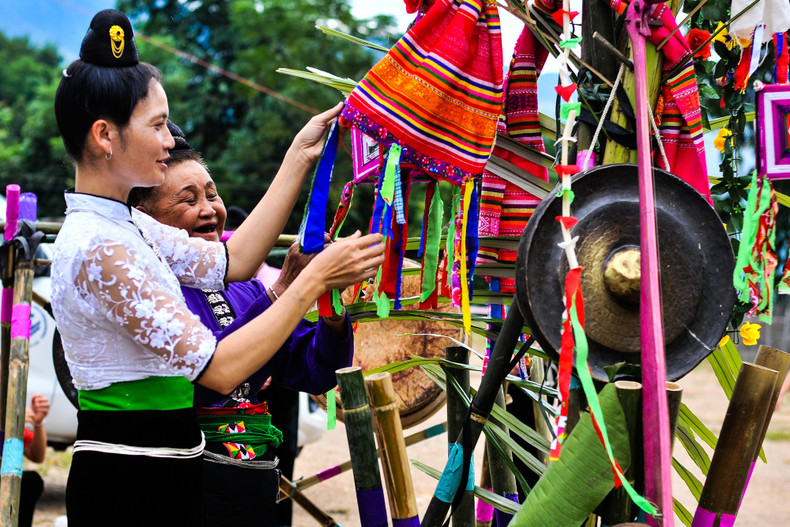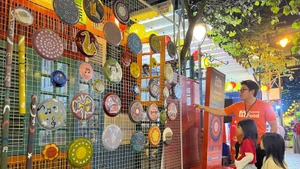Having been taught by her mother to make a Pieu scarf since she was a little girl, Lo Thi Thim is praised as one of the best Pieu embroiderers in Nam Khao Village, Muong Mo Commune, Nam Nhun District.
Every day, during her spare time, Thim and other members of the village's art troupe make Pieu scarves for daily use and sell them to tourists.
Thim said that in recent years, as her hometown targets to develop community-based tourism, Pieu scarves have become favourite souvenirs for tourists to the village.
Although the income from the product is not much, it is very meaningful for the villagers as it shows visitors are attracted to the local traditional cultural products.
Thai ethnic people in Muong Mo, in particular, and the Thai people in Lai Chau Province, in general, make Pieu scarves from self-woven cotton fabric.
There are many different versions of Pieu scarves, and some are embroidered with colourful threads, some are just a piece of indigo-dyed cotton fabric.
According to the villagers, whether the scarf is embroidered or kept in the original indigo colour depends on the culture of each region and each locality.
In addition to being an item to cover the head from the sun and wind, the Pieu scarf is also an important accessory for Thai women in their daily lives, especially when going out or attending festivals, weddings, or major traditional celebrations.
 |
| There are many different versions of Pieu scarves |
Lo Thi Than in Muong Mo Village, Muong Mo Commune, said it takes three to four weeks to complete a Pieu scarf. The embroidery of scarves, particularly the decorations at the two ends of the scarf, is the most time-consuming process.
The skill and talent of a Thai woman can be evaluated through her embroidery techniques while executing patterns on the Pieu scarf. The patterns include popular images in daily life, such as flowers, leaves, five-pointed stars, and insects.
What makes the embroidery on the Pieu scarf more difficult is that the pattern pieces should be placed on the left side of the fabric rather than on the right side, like the usual embroidery method.
This requires Thai ethnic women to calculate an accurate principle to bolt the thread into the left side so that the pattern will appear exactly on the right.
The embroidered patterns on the Pieu scarf are dotted with sophisticated colours with complicated layouts, requiring practitioners to master techniques and have a rich imagination, especially knowing the motifs and patterns with both right and left sides.
 |
| The decorative layout on the Pieu scarf illustrates the harmonious combination of colours and patterns. |
The decorative layout on the Pieu scarf illustrates the harmonious combination of colours and patterns. It is the symphony of the green of the mountains and forests, the yellow of the sunlight and the ripe rice fields, and the pink and white of flowers and grass. Each pattern represents the love of the Thai people for nature and the village.
The Pieu scarf also holds significant meanings in the cultural and spiritual life of the Thai ethnic people.
In the past, the embroidery technique was a criterion for elders when choosing a daughter-in-law. The Thai people believed that if a girl did not know how to embroider a Pieu scarf, she would be lazy and wouldn’t catch the boys' attention.
Therefore, Thai ethnic girls were taught by their mothers how to embroider after school. Embroidery techniques, including Pieu scarf embroidery, are also included in the curriculum of many schools as an extracurricular subject to preserve the traditional cultural identity of Thai ethnic people.
Nguyen Trong Hien - Deputy Director of Lai Chau Provincial Museum and a celebrated researcher on Thai ethnic culture in Lai Chau Province, revealed that in ancient society, the Pieu scarf was used to distinguish between the rich and the poor, between the mature women and girls.
Today, the Pieu scarf is still an important item in the daily life of Thai ethnic women.
The Pieu scarf is an offering at a wedding, a symbol of a festival and belonging accompanying the dead to the afterlife. Despite the passage of time, the Pieu scarf has been established as a symbol with great significant meanings in the life of the Thai ethnic community in Lai Chau Province.
















